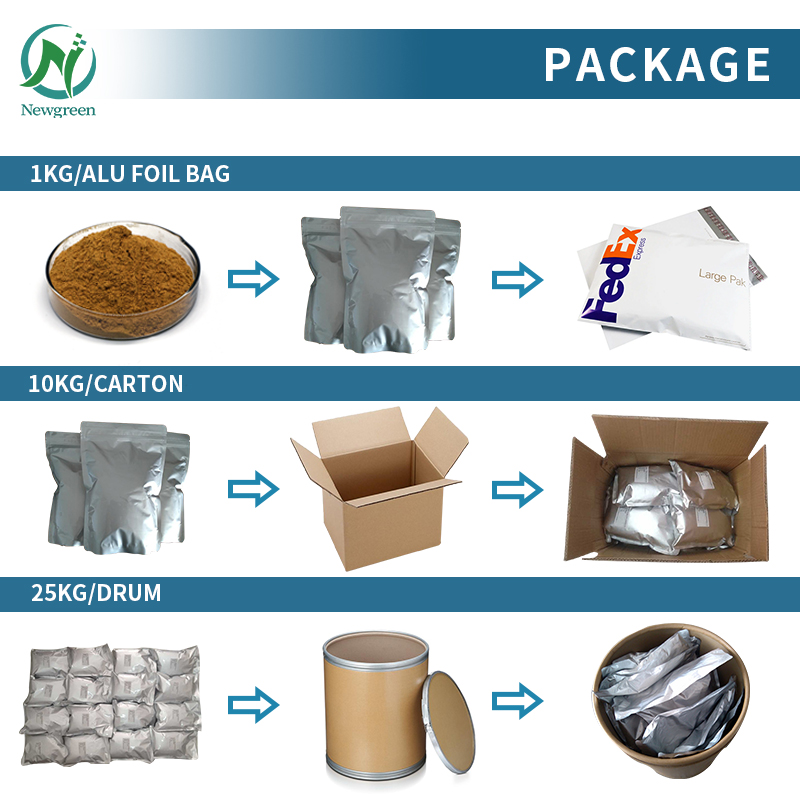Newgreen Factory Supply Extract Food Grade Pure Cranberry Anthocyanins Powder 25%

Product Description
Cranberry (scientific name: Vaccinium macrocarpon) is a small red berry that has received widespread attention for its rich nutritional content and health benefits. Cranberry anthocyanins are an important natural pigment in cranberries. They are anthocyanin compounds and have a variety of biological activities.
Introduction to cranberry anthocyanins
1.Color: Cranberry anthocyanins give the fruit their bright red or purple color, and this pigment is not only beautiful to look at but also has a variety of health benefits.
2.Antioxidant: The anthocyanin in cranberries is a powerful antioxidant that can neutralize free radicals, slow down cell aging, and reduce the damage of oxidative stress to the body.
3.HEALTH BENEFITS:
Urinary Tract Health: Cranberries are widely used to prevent and relieve urinary tract infections (UTIs), and their anthocyanins inhibit bacteria from adhering to the walls of the urethra.
Cardiovascular Health: Cranberry anthocyanins may help improve cardiovascular health and reduce the risk of heart disease and stroke.
AntiInflammatory Effects: The anthocyanins in cranberries have antiinflammatory properties that may help reduce chronic inflammation.
4.Nutritional Facts: In addition to anthocyanins, cranberries are rich in vitamin C, fiber, minerals and other phytochemicals, further enhancing their health benefits.
COA
| Item | Specification | Result | Method |
| Maker Compounds | Cranberry Anthocyanins ≥25% | 25.42% | UV (CP2010) |
| Organoleptic | |||
| Appearance | Amorphous powder | Conforms | Visual |
| Color | Purplered | Conforms | Visual |
| Part Used | Fruit | Conforms | |
| Extract Solvent | Ethanol & Water | Conforms | |
| Physical Characteristics | |||
| Particle Size | NLT100%Through80 | Conforms | |
| Loss on Drying | 三5.0% | 4.85% | CP2010Appendix IX G |
| Ash content | 三5.0% | 3.82% | CP2010Appendix IX K |
| Bulk Density | 4060g/100ml | 50 g/100ml | |
| Heavy metals | |||
| Total Heavy Metals | ≤10ppm | Conforms | Atomic Absorption |
| Pb | ≤2ppm | Conforms | Atomic Absorption |
| As | ≤1ppm | Conforms | Atomic Absorption |
| Hg | ≤2ppm | Conforms | Atomic Absorption |
| pesticide residue | ≤10ppm | Conforms | Atomic Absorption |
| Microbiological Tests | |||
| Total Plate Count | ≤1000cfu/g | Conforms | AOAC |
| Total Yeast & Mold | ≤100cfu/g | Conforms | AOAC |
| E.Coli | Negative | Negative | AOAC |
| Salmonella | Negative | Negative | AOAC |
| Staphylococcus | Negative | Negative | AOAC |
| Expiration Date | 2 Years When Stored properly | ||
| Total Heavy Metals | ≤10ppm | ||
| Packing and Storage | Inside: doubledeck plastic bag,outside:Neutral cardboard barrel& Leave in the shady and cool dry place. | ||
Function
- Cranberry (scientific name: Vaccinium macrocarpon) is a fruit rich in nutrients, and its anthocyanins are one of its main active ingredients. Cranberry anthocyanins have a variety of functions and health benefits, here are some of the main ones:
1. Antioxidant effect
Cranberry anthocyanins are powerful antioxidants that can neutralize free radicals in the body, slow down cell aging, and reduce the damage caused by oxidative stress to the body.
2. Promote cardiovascular health
Research shows that cranberry anthocyanins may help improve cardiovascular health, lower cholesterol levels, and improve blood vessel function, thereby reducing the risk of heart disease and stroke.
3. Antiinflammatory effect
Cranberry anthocyanins have antiinflammatory properties that may help reduce chronic inflammation and reduce the risk of inflammationrelated diseases.
4. Prevent urinary tract infection
Cranberries are widely used to prevent urinary tract infections (UTIs) because their anthocyanins inhibit bacteria (such as E. coli) from adhering to the walls of the urinary tract, thereby reducing the risk of infection.
5. Improve digestive health
The anthocyanins in cranberries may help promote intestinal health, improve digestive function, and prevent constipation.
6. Enhance immunity
The antioxidant and antiinflammatory properties of cranberry anthocyanins may help enhance immune system function and improve the body's resistance.
7. Protect oral health
Some studies suggest that cranberry anthocyanins may help prevent gum disease and oral infections and promote oral health.
8. Possible anticancer effects
Preliminary research suggests that anthocyanins in cranberries may have anticancer properties, inhibiting the growth of certain cancer cells.
In summary, cranberry anthocyanins are a natural ingredient with multiple health benefits, and when consumed in moderation, can support the body in many aspects. Combined with other healthy diet and lifestyle options, cranberries and their anthocyanins may help improve overall health.
Application
- Cranberry Anthocyanins are natural pigments extracted from cranberries (Vaccinium macrocarpon) and have a variety of health benefits and applications. The following are the main application areas of cranberry anthocyanins:
1. Food and Beverages
Natural Colors: Cranberry anthocyanins are often used as natural colorings in foods and beverages, especially in juices, jams, drinks, candies and pastries, providing a bright red color.
Functional Drinks: Cranberry drinks are popular for their rich anthocyanin and antioxidant properties and are often promoted as functional drinks that support health.
2. Health products
Nutritional Supplements: Cranberry anthocyanins are extracted and made into capsules or tablets as antioxidants and health products to help improve urinary tract health, enhance immunity, etc.
Prevents Urinary Tract Infections: Cranberry extract is often used to prevent and relieve urinary tract infections due to its ability to inhibit the ability of bacteria to adhere to the walls of the urethra.
3. Cosmetics
SKIN CARE: Due to its antioxidant and antiinflammatory properties, cranberry anthocyanins are added to skin care products to help fight skin aging, improve skin tone and moisturize.
4. Research and Development
Scientific Research: The biological activities and health benefits of cranberry anthocyanins are the subject of many studies, driving scientific exploration and new product development in related fields.
5. Traditional culture
Food Culture: In some areas, cranberries are widely used in traditional diets as a popular ingredient, especially in holiday foods.
6. Food industry
Preservatives: Cranberry anthocyanins have certain antibacterial properties and can be used as natural preservatives to extend the shelf life of food.
In short, cranberry anthocyanins have been widely used in many fields such as food, health products, and cosmetics due to their rich nutritional value and multiple functions. As people's focus on health and natural ingredients increases, the application prospects of cranberry anthocyanins remain broad.
Related products:

Package & Delivery



















